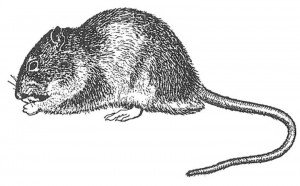Latin: Rattus norvegicus.

The brown rat is found all over the world. It originated in East Asia, from where it has spread, partly on foot and partly by sea on ships. It arrived relatively late into Europe. We first hear about “wandering rats” ravaging the continent in the early 1700s. The brown rat has great adaptability and it quickly drove away the black rat, which until then was the most common species in houses.
An adult brown rat is about 45 cm long. Of these, 20 cm is tail. The weight is usually 200 – 250 g. The colour varies somewhat, but the upper surface is usually dark brown or noble. The underside varies from whitish to grey. The brown rats thrive on the most diverse locations, but are primarily found in stables, warehouses and homes. In towns and cities, they often live in waste water pipes. Rat invasions in urban property are almost always due to sewer rats that come up through a break in a pipe. The rat is practically omnivorous. It prefers cereal products, but it also eats meat and may occasionally arise as a predator that eats chickens and other small animals. An adult rat eats an amount of feed that corresponds to 1/10 of its own body weight a day. Some of the places in the world where people have little access to food, the rats eat more than half of the stored food. In our latitudes rats’ main demerits are the gnawing of packaging and products, as well as contamination of food. There is no doubt that rats (and mice) are responsible for a large part of the food poisoning caused by Salmonella bacteria.
The brown rat breed all year round. One pair of rats that are doing well in a granary or stable can in the course of a year produce 800 rats. Rats live in herds and they recognise each other by smell. The rats are shy animals that are primarily active during the dark hours. They are suspicious of new objects and do not cross open areas, but move along walls.




